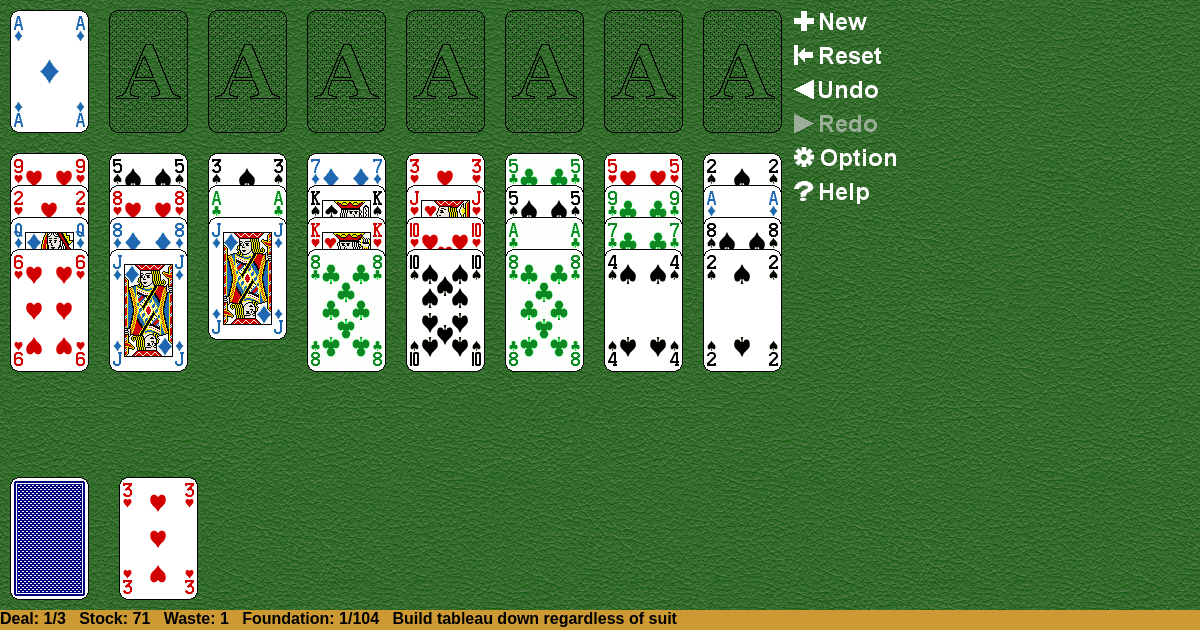Rows of Four
Home |
How to play |
FAQ |
About
How to play Rows of Four?
Rows of Four Solitaire: Comprehensive How to Play Guide
Game Objective
The primary goal in Rows of Four Solitaire is to move all 104 cards from the tableau and stock to the eight foundation piles. A player wins by successfully building each foundation pile in sequence from Ace to King in the same suit.
Setup & Layout
Rows of Four Solitaire is played with two standard decks of 52 cards each, totaling 104 cards. The game begins with the following initial arrangement:
Tableau: Eight tableau piles are created, each containing exactly four cards dealt face-up. All cards in the tableau are visible to the player from the start of the game.
Foundations: Eight foundation piles are established, one for each suit from both decks (two piles per suit). These piles begin empty and serve as the destination for all cards during play.
Stock: The remaining cards that are not dealt to the tableau form the stock pile. Cards from the stock are drawn one at a time during gameplay.
Waste: A single waste pile receives cards drawn from the stock. The top card of the waste pile is always available for play.
Rows of Four Solitaire Rules
Foundation Building Rules
The eight foundation piles are built upward in sequence by the same suit, beginning with an Ace. For example, the 5♠ may only move onto the 4♠, and the 5♦ may only move onto the 4♦. A valid sequence on a foundation would be: 5♥, 6♥, 7♥, 8♥, 9♥, continuing up to the King.
An Ace is the only card that may be placed on an empty foundation to begin a new sequence.
Tableau Building Rules
The eight tableau piles are built downward by rank, regardless of suit. This means a card may move onto any card of the next higher rank, regardless of color or suit. For example, the 7♠ may move onto the 8♠, 8♥, 8♣, or 8♦. A valid sequence on a tableau would be: 7♥, 6♠, 5♠, 4♦, 3♣, continuing downward.
Only the top card of each tableau pile is movable at any given time. When the top card is moved, the card beneath it becomes available for play.
Card Movement Between Play Areas
Cards may be moved from the tableau to the foundations if they follow the foundation building rules (upward by suit). Cards may be moved from the waste pile to either the foundations or the tableau, provided they follow the respective building rules for each area.
When a tableau pile becomes completely empty (all four cards have been moved), a card from the waste pile may move to that empty tableau space.
Gameplay
Turn Sequence
During each turn, a player may perform the following actions in any order:
- Move cards from the tableau to the foundations if legal moves are available.
- Move cards from the waste pile to the foundations if legal moves are available.
- Move cards from the waste pile to the tableau if legal moves are available.
- Draw a card from the stock to the waste pile if no other moves are possible or desired.
A player may continue making moves as long as legal moves exist. When no further moves are available, the player must draw from the stock.
Stock and Waste Mechanics
The stock pile is drawn one card at a time, with each card placed face-up on the waste pile. When the stock is exhausted, the waste pile may be reshuffled back into the stock for another pass.
Two redeals of the waste pile back into the stock are permitted, allowing for three complete passes through the stock in total. Once all three passes are complete and no moves remain, the game ends.
Winning & Losing Conditions
Winning
A player wins the game by successfully moving all 104 cards to the eight foundation piles, with each foundation built completely from Ace to King in the same suit.
Losing
A player loses the game when:
- All three passes through the stock have been completed, and no legal moves remain available on the tableau or waste pile.
- The game reaches a state where cards are blocked and cannot be moved to either the foundations or the tableau, making further progress impossible.
Special Rules & Edge Cases
Empty Tableau Spaces
When a tableau pile becomes empty (all four cards have been removed), only a card from the waste pile may fill that empty space. Cards cannot be moved directly from other tableau piles to fill empty spaces; they may only move to other tableau piles if they follow the downward-by-rank building rule.
Redealing the Stock
After the initial pass through the stock is exhausted, the waste pile is collected and reshuffled to form a new stock. This process may occur up to two additional times, for a total of three complete passes through the deck. The player must manually initiate each redeal; it does not occur automatically.
Top Card Availability
At any point during the game, only the top card of the tableau piles and the top card of the waste pile are available for play. Cards beneath these top cards cannot be moved until the cards above them have been removed.




























































